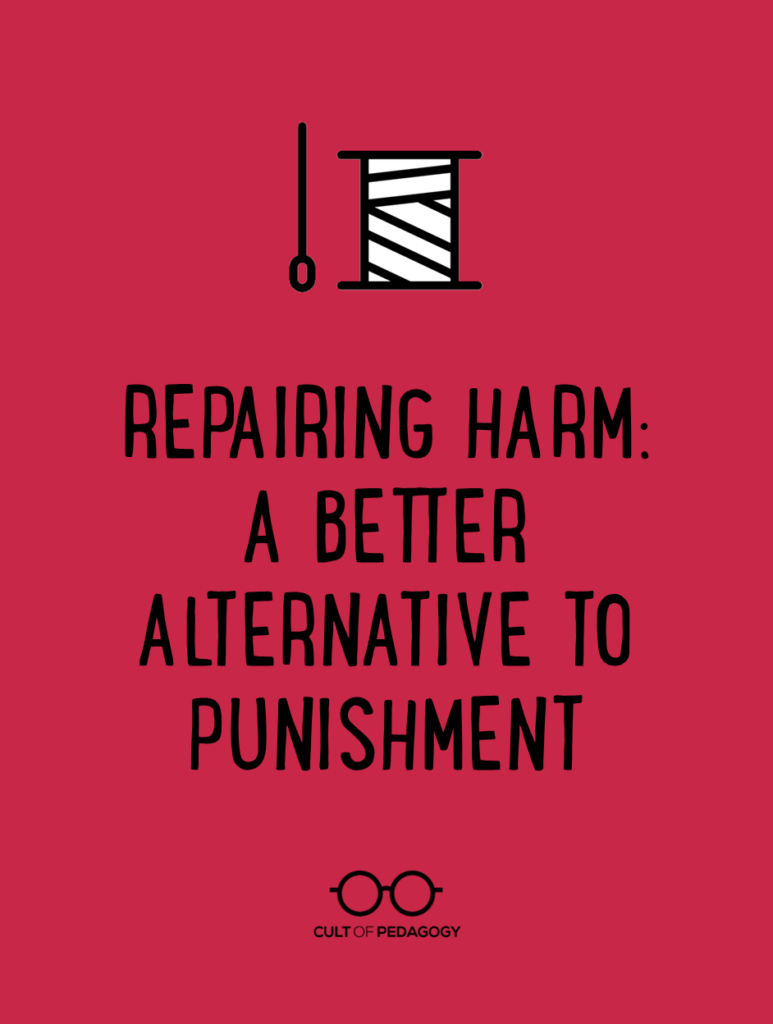
Listen to my interview with Nathan Maynard
and Brad Weinstein (transcript):
Sponsored by Public Consulting Group and ViewSonic
This post contains Amazon Affiliate links. When you make a purchase through these links, Cult of Pedagogy gets a small percentage of the sale at no extra cost to you.
When students behave in ways that are disruptive, when they do things that harm others, or when they otherwise make choices that go against established rules, schools often respond with punishment: removal from class, a phone call home, detention, suspension, even expulsion if the behavior is considered extreme enough.
It’s been this way forever, at least in traditional western schools, and most of the time, these punishments don’t really work. Sure, they remove the student from the situation, temporarily stopping the challenging behavior. And it could be argued that in general, many students choose to follow the rules because the threat of punishment acts as a deterrent; they don’t want to get in trouble, so an acceptable level of order is maintained.
But punishments don’t really do anything to address or correct the source of the misbehavior, and most of the time, they do nothing to fix any damage that may have been caused by it. On top of that, exclusionary punishments like suspensions create their own set of problems: When students are removed from class, they miss instruction, putting them behind their classmates and making them more likely to fail academically. This often leads to higher dropout rates and puts far too many students—especially students of color—on the path to prison.
After decades of using these ineffective practices, more schools are turning to restorative justice, an approach to student behavior that originated in the criminal justice system. In 2018, Victor Small, Jr and I did a broad overview of Restorative Justice to go over the basics.
Now I’m going to narrow the lens to one specific restorative practice called repairing harm. This is when, instead of simply being sent off to a punishment, a student who has misbehaved is tasked with figuring out how to repair whatever damage was caused by their behavior, and then to actually carry out that repair with everyone who was impacted by their actions.
To learn about this practice, I talked to Brad Weinstein and Nathan Maynard, authors of the book Hacking School Discipline: 9 Ways to Create a Culture of Empathy & Responsibility Using Restorative Justice. Weinstein is a former classroom teacher and administrator, and Maynard started his career in the juvenile justice system before going into teaching. Now they work together at Behavior Flip, a digital behavior management system built on the principles of restorative justice.


In their book, Brad and Nathan share the restorative justice strategies they’ve used successfully for years with students. In our conversation (which you can listen to above), they took me step-by-step through one of those strategies: the process of repairing harm after a misbehavior as an alternative to punishment.
How Repairing Harm Works
1. Identify the Harm and the Stakeholders
After an incident has occurred, the student meets with the administrator or other adult responsible for behavior management. In a private conference, the two work together to identify the harm caused by the behavior and all of the stakeholders who were impacted by it.
This list of stakeholders often turns out to be longer than the student first thought.
“A lot of times students don’t understand that a behavior has a ripple effect,” Maynard says. “Like throwing a rock into a pond, it affects a lot of different people. We have to show them what those ripples are and who those really are affecting, so when they’re repairing the harm they need to think of each stakeholder individually. That’s developing the empathy skills for each and every one of them.”
2. Consider How the Behavior Affected Others
Once all stakeholders have been identified, it’s time for the student to think deeply about how all of them were impacted by the behavior. This exercise in empathy will help the student come up with the right repair later.
Sometimes this process requires help from the adults. Maynard describes what this could look like, starting by saying something to the student along these lines: “When you throw something in a class, and let’s say that hits someone else, how do you think their mother would feel if I called them up and said, hey their son just got hurt in class? Something like that that’s going to drive the empathy and create that sense of, oh, another stakeholder is that kid’s parent.”

3. Create and Carry Out a Plan to Repair the Harm
Finally, the student—not the administrator—creates a plan to repair the harm with every stakeholder. The plan doesn’t have to be anything elaborate; it can be as simple as an apology.
“Let’s say a student was yelling at the class,” Maynard says. “That affects the rest of the class. What can you do to repair it (with them)? Sometimes I’ve had students go in front of the class and just apologize. Something like that—owning that behavior—shows the rest of the class that it’s not acceptable.”
Although some might see this as getting off easy, consider the courage it takes to stand up in front of your peers and publicly admit wrongdoing. “I mean,” Maynard says, “that’s a lot more tough than sitting at home for three days.”
There are times, though, when sorry isn’t enough. “Prime example, student throws food across the cafeteria,” Weinstein says. “They spill milk all over the floor, they cause a big mess. If they just say, I’m sorry, you just say, I’m glad that you apologized, but I think we’re going to have to do something a little bit more, because you caused a mess. Who are the stakeholders? They might realize that there is somebody that has to clean up after them, and they’re going to take away time from their job—as somebody who cleans the tables, I have to go home 20 minutes late now, because I’m cleaning your mess.”
Weinstein says in cases like this, the solution “might look like cleaning all of the tables, mopping the floor, and working with the custodian to help clean, because when they cause harm to the environment, a good way to repair that harm is to make that environment clean. If I were to just put (the student) in detention or ISS for the rest of the day, that would teach that kid to not get caught next time. They wouldn’t have any understanding of who they hurt, why what they did was a bad thing, and how they can repair that harm.”
Questions About this Process
Won’t this take extra time?
It depends on how you look at it. Punishment is definitely quicker than working with a student to consider the impact of behavior on stakeholders and develop a plan for repair. But because traditional punishment doesn’t usually end the behavior, you’re likely to spend more time on it later.
“An Edutopia article just recently came out that says classroom management takes about 144 minutes per week out of (instructional time),” Maynard says. “So if you think about 144 minutes per week, think about what can you do to integrate these proactive approaches and meet those kids’ needs.”
This idea is captured in the quote that starts the book’s chapter on repairing harm, from author Pam Leo: “Either we spend time meeting children’s emotional needs by filling their cup with love or we spend time dealing with the behaviors caused from their unmet needs. Either way we spend the time.”

What if the student denies the behavior?
Sometimes a student will flat-out deny having done the thing they’re being accused of doing. This can even happen when you, the teacher, were an eye witness.
When this happens, Maynard gives students two choices. “I say, okay. I believe this was you, and if I’m wrong, I’m wrong. Let’s deal with this situation now, fix it, move forward. Right now it’s just between me and you. If I find out later that it’s you, then there’s just going to be an additional situation. Why not just deal with it right now and then if there’s an additional situation that’s showing that you’re dishonest, (then) I have to deal with what happened and you being dishonest, instead of just what happened. You make the choice.”
Afterwards, he always gives students time to process, to think about what they want to do. “Because immediately if I say something like that, they’re still going to be oppositional,” he explains. “So I give them some time to process what’s going on. I back away, say okay, I’m going to give you a few minutes.”
When he does this, Maynard says, students will often calm down and become more cooperative. “Giving them that time really does help out.”
Shouldn’t People Suffer at Least a Little Bit After Doing Something Wrong?
When someone misbehaves, our logic tells us that they should experience some kind of negative consequence; otherwise how will they learn not to do it again?
On top of that is the fact that we’re all human. After a student has disrespected us or caused a problem for us, we might honestly start itching for a bit of revenge.
“Punishment makes us feel better sometimes,” Maynard says. “You know, someone did something wrong, they harmed me, I want there to be some sort of harm. We’ve heard someone say before, you disrespected me, so now you need to suffer a little bit.”
But underneath that feeling is a desire to have the student experience real regret, a regret that can be deeper and longer-lasting if it emerges in the student from a place of empathy.
“That statement shows that (teachers) do want to show the students how to be empathetic and realize how they felt.” Maynard says. “Restorative practice is the way to do that, but it’s just less traumatic. And it’s a way more effective way to open up that child’s eyes to how their behavior made us feel.”
To learn more, follow Nathan on Twitter at @NmaynardEdu and Brad at @WeinsteinEdu, visit their website at hackingschooldiscipline.com, join their Hacking School Discipline Facebook group, and explore their app, BehaviorFlip, at behaviorflip.com.
Join our mailing list and get weekly tips, tools, and inspiration that will make your teaching more effective and fun. You’ll get access to our members-only library of free downloads, including 20 Ways to Cut Your Grading Time in Half, the e-booklet that has helped thousands of teachers save time on grading. Over 50,000 teachers have already joined—come on in.
